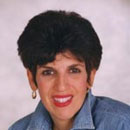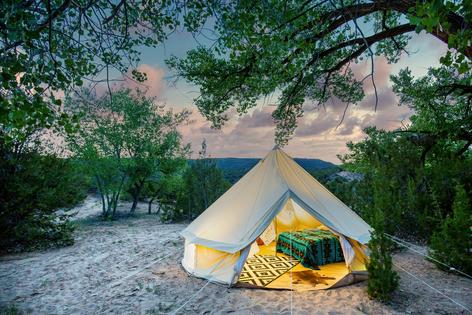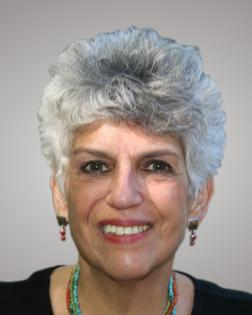Taking the Kids: Family camping trends – dogs over kids – who knew?
Would you rather take your dog or your kids on vacation?
Campers prefer their dogs, it appears. More than half of campers choose to camp with their four-legged friends, outpacing the number of campers choosing to camp with other family members (21 percent), siblings (13 percent) or parents (10 percent), according to the new Kampgrounds of America annual report that looks at the latest camping trends.
Unlike in hotels, there isn’t a big extra fee for a dog. In fact, some campgrounds, like KOA, and Yogi Bear’s Jellystone Parks even have fenced-in doggie play areas and dog splash parks.
More campers are getting away on their own. “That has been interesting to watch,” said KOA Senior Vice President of Marketing Diane Eichler. “Many of these solo campers are taking trips with their dogs and seeking social interactions with other travelers, which aligns with camping being an inherently social activity. They are looking to develop new friendships during their travels.”
Another interesting trend, Eichler said, was the growth in the number of campers using AI in trip planning – more than 60 percent, nearly double that of leisure travelers. Research also shows that they would camp even more days if they knew they had reliable Wi-Fi, Eichler said. “Access to Wi-Fi and technology on the road is very important to campers,” she said, as many campers opt to work while camping.
And who knew adults were as excited by s’mores as kids are? Half of campers without kids are most excited about s’mores. (Full disclosure: I wrote the Kid’s Guide to Camping in partnership with KOA.) Campers report they want to get back to the basics with more than a fourth of campers wanting to reconnect with family over old-school traditions like making s’mores.
“Connection – with loved ones, friends and family – was a primary motivator to camp from this year's research,” Eichler said.
So is prioritizing mental health. Forty-two percent of campers say they are looking to enhance their well-being while camping, and more than half seek wellness by the water.
Camping is also perceived as a less-stressful family vacation option; despite all the effort it requires. One-third of campers’ report that camping with kids is more relaxing than other forms of travel.
That’s not necessarily true when kids are young, said Rachel Mastudino, a Salt Lake City teacher and mom of two kids, five and three.
“It wasn’t until our younger one was two and a half that the stress-to-fun ratio actually tipped more toward fun,” she said. “It can be very stressful to bring toddlers and infants camping because sleep and safety needs are greater.”
Colorado dad Jonathan Boydston, who has camped with his toddler, agreed. While his family loves getting outdoors, it can be difficult when his young son wakes up early, disturbing nearby campers or their late-night activities keep him awake. “It pays to find a site that has a little privacy and space between neighbors,” he suggested.
Mastudino added it actually is easier “not to camp in this stage of life, but we try to prioritize it once or twice a year because we want to instill certain values in our kids. “The best part,” she said, “is experiencing their wonder at each new place we explore together … it’s like landscapes that are old hat to me are new and wondrous to my kids and I get to experience all of that again.”
Certainly, older kids can have more freedom in a campground than in a hotel, riding bikes and scooters, making new friends, discovering that nature can be the best toy.
“They just get out there and run wild, the less they have the more inventive they become … whacking things with sticks, collecting rocks, arranging rocks,” said one California grandfather who camps with his son and two grandsons. “The only thing they need is food and snacks.“
Another plus: The kids get so exhausted, they go to sleep early, leaving plenty of adult time around the campfire.
Clearly the cost-effectiveness of camping is a motivator, 72 percent of campers told KOA, though gear can be an initial expense. More than half of those who camp with kids do it to save money. More than half of campers have children in the household.
“This report shows that while campers are adjusting their plans (because of economic concerns), they’re not canceling them,” Eichler observed, noting that they are taking shorter trips, staying closer to home or even canceling other types of trips and choosing camping instead.
No wonder camping is having a moment. Well, actually another moment. Families first headed outdoors in droves during the pandemic when they wanted to stay away from crowds and enjoy what was still open – the Great Outdoors.
That appeal has only continued to grow, according to the new KOA report. Eleven million more households camped in 2024 versus 2019. One million households report they will try camping this year. Not surprisingly, Gen Z and Millennials represent 61 percent of new campers.
Those new to camping are especially drawn to glamping – the opportunity to go outdoors without having to pitch your own tent or even prepare meals. Nearly a third of new campers last year were glamping.
Some glamping resorts, like Paws Up in Montana, boast individual bathrooms, even bathtubs and butlers to cater to every whim. The growing number of Under Canvas locales are just outside national parks, making visits easier.
Another appeal is that many campgrounds have morphed into outdoor resorts with kids’ activities, playgrounds, arts and crafts, swimming pools, bird watching, stargazing, game nights, scavenger hunts, even campfire cooking demonstrations at a fraction of the cost of traditional resorts.
Just as important in drawing new campers, is their growing diversity. More than a third of campers, according to the report, are nonwhite; nearly a fourth of new campers last year were Black. There is a significant rise in camping in single-sex households, those who camp with grandparents and other extended family members and those with special needs. Twenty-nine percent say accessible options are important.
Ten million households are RVers, according to the report. Nearly 40 percent of campers say they are interested in trying an RV this year. Many of those I’ve met, RVing, have said it is a lot easier with young kids, kids with special dietary needs and, of course, when it rains. It’s also easier these days to rent an RV with websites like www.RVShare.com and Outdoorsy, connecting owners with people who want to rent from them, in some cases even setting the rental up in a campground. A membership with Harvest Hosts enables RVers to park overnight at nearly 10,000 locations, including farms, orchards, wineries and breweries.
Just don’t forget to make those campground reservations. And wherever you go or however you camp, remember to bring plenty of s’mores fixings.
========
(For more Taking the Kids, visit www.takingthekids.com and also follow TakingTheKids on Twitter, Facebook and Instagram where Eileen Ogintz welcomes your questions and comments. The fourth edition of The Kid’s Guide to New York City and the third edition of The Kid’s Guide to Washington D.C. are the latest in a series of 14 books for kid travelers published by Eileen.)
©2025 Eileen Ogintz. Distributed by Tribune Content Agency, LLC.
(c) 2025 DISTRIBUTED BY TRIBUNE MEDIA SERVICES, INC.
















Comments